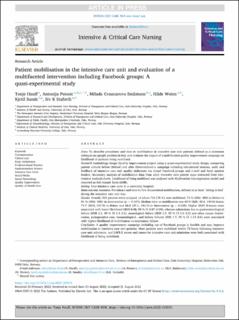| dc.contributor.author | Hauff, Tonje | |
| dc.contributor.author | Petosic, Antonija | |
| dc.contributor.author | Småstuen, Milada Cvancarova | |
| dc.contributor.author | Wøien, Hilde | |
| dc.contributor.author | Sunde, Kjetil | |
| dc.contributor.author | Stafseth, Siv Anna Ulla-Britt Karlsson | |
| dc.date.accessioned | 2022-12-27T10:51:04Z | |
| dc.date.available | 2022-12-27T10:51:04Z | |
| dc.date.created | 2022-10-10T10:45:09Z | |
| dc.date.issued | 2022 | |
| dc.identifier.issn | 0964-3397 | |
| dc.identifier.uri | https://hdl.handle.net/11250/3039511 | |
| dc.description.abstract | Aims: To describe prevalence and time to mobilisation in intensive care unit patients defined as a minimum
sitting in an upright position in bed, and evaluate the impact of a multifaceted quality improvement campaign on likelihood of patients being mobilised.
Research methodology/design: Quality improvement project using a quasi-experimental study design, comparing patient cohorts before (Before) and after (Intervention) a campaign including educational sessions, audit and feedback of intensive care unit quality indicators via closed Facebook-groups and e-mail and local opinion leaders. Secondary analysis of mobilisation data from adult intensive care patient stays extracted from electronical medical charts. Likelihood of being mobilised was analysed with Multivariate Cox-regression model and reported as Sub-hazard Ratio (SHR).
Setting: Four intensive care units in a university hospital.
Main outcome measures: Prevalence and time to first documented mobilisation, defined as at least “sitting in bed” during the intensive care unit stay.
Results: Overall, 929 patients were analysed, of whom 710 (76 %) were mobilised; 73 % (356/ 489) in Before vs 81 % (354/ 440) in Intervention (p = 0.007). Median time to mobilisation was 69.9 (IQR: 30.0, 149.8) hours; 71.7 (33.9, 157.9) in Before and 66.0 (27.1, 140.3) in Intervention (p = 0.104). Higher SAPS II-scores were associated with lower likelihood (SHR 0.98, 95 % CI 0.97–0.99), whereas admissions due to gastroenterological failure (SHR 2.1, 95 % CI 1.4–3.0), neurological failure (SHR 1.5, 95 % CI 1.0–2.2) and other causes (intoxication, postoperative care, haematological-, and kidney failure) (SHR 1.7, 95 % CI 1.13–2.6) were associated with higher likelihood of mobilisation vs respiratory failure.
Conclusion: A quality improvement campaign including use of Facebook groups is feasible and may improve mobilisation in intensive care unit patients. Most patients were mobilised within 72 hours following intensive care unit admission, and SAPS II scores and causes for intensive care unit admission were both associated with likelihood of being mobilised. | en_US |
| dc.language.iso | eng | en_US |
| dc.rights | Navngivelse 4.0 Internasjonal | * |
| dc.rights.uri | http://creativecommons.org/licenses/by/4.0/deed.no | * |
| dc.subject | Intensivsykepleie | en_US |
| dc.subject | Kommunikasjon | en_US |
| dc.title | Patient mobilisation in the intensive care unit and evaluation of a multifaceted intervention including Facebook groups: A quasi-experimental study | en_US |
| dc.title.alternative | Patient mobilisation in the intensive care unit and evaluation of a multifaceted intervention including Facebook groups: A quasi-experimental study | en_US |
| dc.type | Peer reviewed | en_US |
| dc.type | Journal article | en_US |
| dc.description.version | acceptedVersion | en_US |
| dc.source.journal | Intensive & Critical Care Nursing | en_US |
| dc.identifier.doi | 10.1016/j.iccn.2022.103315 | |
| dc.identifier.cristin | 2059978 | |
| cristin.ispublished | true | |
| cristin.fulltext | postprint | |
| cristin.qualitycode | 1 | |

